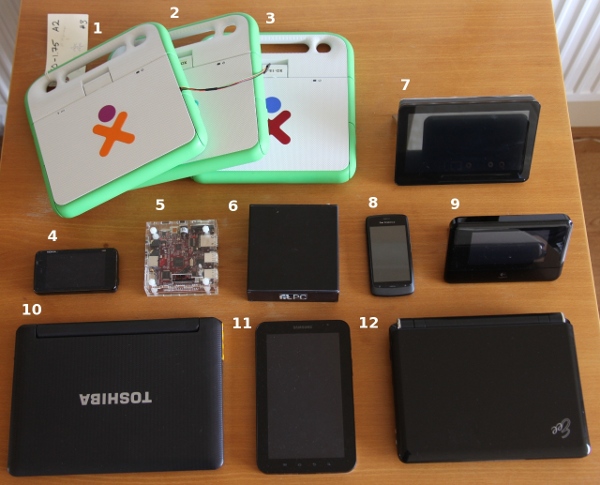I’ve been meaning to do a post with details of all the small devices I have. Not all the devices pictured below currently run Fedora although nine out of the twelve shown either currently run Fedora or I’ve had them boot Fedora. The three devices that don’t, as yet, boot Fedora are devices 8, 9 and 11. There’s no reason why they can’t as they all run some form of Linux, in the case of 8 and 11 its Android and 9 is a Logitech SqueezeBox Touch.
One of the things that I’ve been trying to achieve in Fedora for many years is slimming of the required dependencies of certain combinations of installs. Not everyone needs everything, and not everyone has Terabytes of storage that can be thrown about.
So what are all the devices above. I’ll go through each one and give some details of each:
- OLPC XO 1.75: 1Ghz ARMv7 Processor, 512Mb RAM, 4Gb eMMC storage, GPU Unknown
- OLPC XO 1.5: 1Ghz VIA C7 Processor, 1Gb RAM, 4Gb microSD storage, VIA VX855 GPU
- OLPC XO 1.0: 433Mhz AMD Geode Processor, 256Mb RAM, 1Gb Flash storage, Geode GPU
- Nokia n900: 800Mhz OMAP3 A8 ARMv7 Processor, 256Mb RAM, 32Gb eMMC storage, PowerVR SGX530 GPU
- BeagleBoard XM: 1Ghz OMAP3 A8 ARMv7 Processor, 512Mb RAM, 8Gb microSD storage, PowerVR SGX530 GPU
- Fit-PC 1.0: 500Mhz AMD Geode Processor, 256Mb RAM, 40Gb HDD, Geode GPU
- O2 Joggler: 1Ghz Z520 Atom Processor, 512Mb RAM, 2Gb Flash storage, GMA-500 Poulsbo GPU
- Orange SanFrancisco AKA ZTE Blade: 600Mhz Qualcomm MSM7227 ARMv6 processor, 512Mb RAM, 150Mb Flash, Adreno 200 GPU
- Logitech SqueezeBox Touch: 600Mhz ARMv6 Processor, 128Mb RAM, 128Mb Flash, GPU Unknown
- Toshia AC100: Dual Core 1Ghz Tegra 250 A9 ARMv7 Processor, 512Mb RAM, 8Gb SSD, GeForce ULP GPU
- Samsung Galaxy Tab:1Ghz Samsung A8 ARMv7 Processor, 512Mb RAM, 16Gb SSD, PowerVR SGX540 GPU
- Asus EeePC 901: 1.6 Ghz Atom Processor, 1Gb RAM, 4Gb Primary SSD, 16 Gb Secondary SSD, Intel G450 GPU
All the devices have WiFi, some have wired Ethernet, some 3G, GPS etc.
There’s two main issues with smaller “mobility” devices. Firstly is the GPU support is obviously a mixed bag, there’s obviously AdamW’s favourite GPU… the Poulsbo on the Intel Z5xx series atoms. The Poulsbo is basically a variant of the PowerVR GPU’s that Intel licenese. Unfortunately this is still basically the case for the new Z6xx series which contain a GMA-600 Poulsbo device. Buyer beware! Its been leaked this week that Intel for later generations isn’t going to improve the situation as they just going to use the PowerVR GPU directly.
The other issue is storage. Most of the devices just don’t have that much of it. This is why I spend so much time filing bugs to split out dependencies. While you can install the standard desktop into 4Gb it doesn’t leave that much for things like yum updates or fun things like music 🙂
